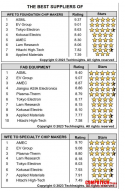China Microelectronics (AMEC) ranks first in two items in TechInsights 2023 Customer Satisfaction Survey List
May 19, 2023--China Micro Semiconductor Equipment (Shanghai) Co., Ltd. (hereinafter referred to as "China Micro", SSE stock code: 688012) announced the 2023 customer conference held by TechInsights, a global technology analysis and intellectual property service provider Won six awards in the Satisfaction Survey (CSS), among which it ranked first in two lists of THE BEST Suppliers of Fab Equipment to Specialty Chip Makers and Deposition Equipment.
In addition to winning the highest evaluation from customers in the above two lists, AMEC also won the following four awards:
Ranked No. 3 among 10 BEST Focused Suppliers of Chip Making Equipment
Ranked No. 1 among THE BEST Suppliers of Fab Equipment to Specialty Chip Makers
Ranked third among global wafer manufacturing equipment suppliers (THE BEST Suppliers of Fab Equipment)
Ranked fifth among THE BEST Suppliers of Fab Equipment to Foundation Chip Makers

May 19, 2023--China Micro Semiconductor Equipment (Shanghai) Co., Ltd. (hereinafter referred to as "China Micro", SSE stock code: 688012) announced the 2023 customer conference held by TechInsights, a global technology analysis and intellectual property service provider Won six awards in the Satisfaction Survey (CSS), among which it ranked first in two lists of THE BEST Suppliers of Fab Equipment to Specialty Chip Makers and Deposition Equipment.
In addition to winning the highest evaluation from customers in the above two lists, AMEC also won the following four awards:
Ranked No. 3 among 10 BEST Focused Suppliers of Chip Making Equipment
Ranked No. 1 among THE BEST Suppliers of Fab Equipment to Specialty Chip Makers
Ranked third among global wafer manufacturing equipment suppliers (THE BEST Suppliers of Fab Equipment)
Ranked fifth among THE BEST Suppliers of Fab Equipment to Foundation Chip Makers




